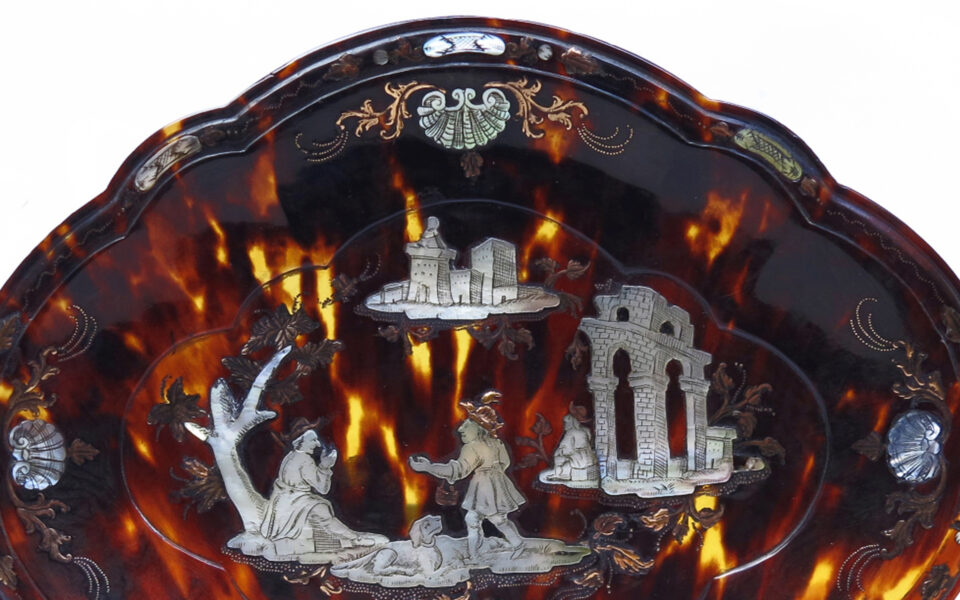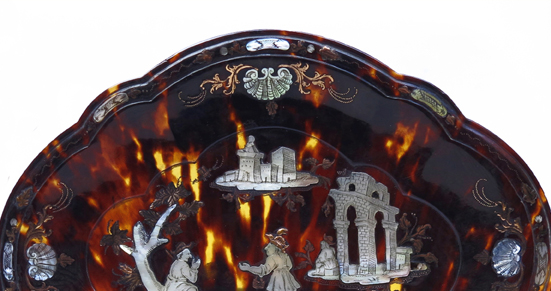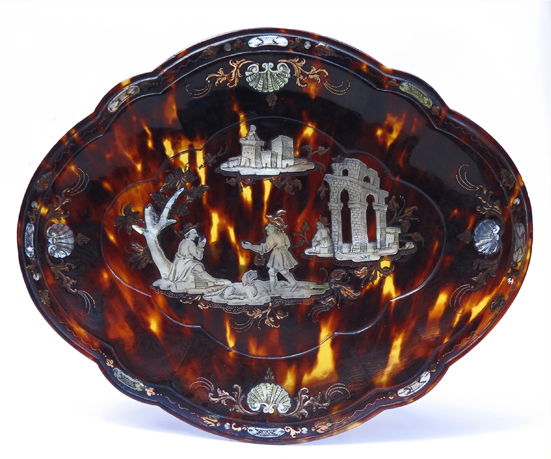
A Neapolitan Piqué Tortoiseshell Tray
This nice tray is a typical example of the so-called tortoiseshell piquè work, a very sophisticated technique probably originated in Naples already around the late 16th century. This art developed significantly a century later, and is described in some 18th century books, revealing processing ‘secrets’: first the softening the tortoiseshell by boiling it in water and olive oil, followed by the shaping through progressive pressure against moulds, and finally by the insertion of decorative patterns and motives, typically in mother-of-pearl, silver and gold; the special combination of these precious materials makes these Neapolitan works really unique.
With its oval and slightly four-lobed profile, the tray has shaped sides, a flaring rim and it’s richly decorated with a pastoral scene – in the middle – with haunters and a dog, sitting among architectures and ruins, and shells and vegetal motifs to the four edges. The scenes enriching these kind of pieces were often inspired by contemporary prints.

The practice of combining precious material dates back to the Antiquity and especially the use of tortoiseshell for furniture veneering, such as tables and cabinets and other objects, is well documented in many different European towns already in the 17th century. However, the Neapolitan tartarugari clearly distinguish from any other, reaching very high peaks during the first half of the 18th century, in conjunction with the arrival of Charles of Bourbon.
Sovereign of Naples since 1734 – the King certainly had a key-role in the promotion and development of the tortoiseshell workshops, like the one led by Giuseppe and Gennaro Sarao, father and son, considered the most important in town.
Neapolitan piqué works soon became so fashionable so as to be often mentioned in their correspondence by famous English Grand Tourists: Sir Horace Walpole ordered in 1740 a tortoiseshell snuffbox for his friend Horace Mann; the renowned architect Robert Adam in 1755 purchased ‘three very handsome snuff-boxes of yellow and black tortoiseshell studded with gold’; an inkwell and two ’picay’ snuffboxes are cited in an inventory of the Queen Charlotte, King George III’s wife.

Some comparable trays can be found in many private collections belonging to the most important European noble families, such as the collection of Baron Ferdinand de Rothschild, now at Waddesdon Manor, as well as in public collections, like the one of the Duca di Martina museum, at Villa Floridiana in Naples.

TRAY
Piqué tortoiseshell inlaid with engraved mother-of-pearl, silver and gold
Naples, circa 1750
Cm 19 x 15,5 h.
References: G. de Bellaigue, The James A. de Rothschild Collection at Waddesdon Manor: Furniture, Clocks, and Gilt Bronzes, vol. II, London, 1974, p. 830-831, n. 233; L’arte della tartaruga: le opere dei musei napoletani e la donazione Sbriziolo-De Felice, exh. catalogue (Napoli, Museo Duca di Martina, 1994-1995) ed. by L. Ambrosio and L. Arbace, 1994.
© 2013 – 2023 cesatiecesati.com | Please do not reproduce without our expressed written consent
Alessandro Cesati, Via San Giovanni sul Muro, 3 – 20121 Milano – P.IVA: IT06833070151